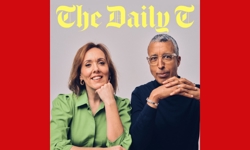Robin Crumby opened the event by highlighting some key themes. The key challenge, he said, was to engage customers in a dialogue – new technologies offer publishers the opportunity to deliver more personalisation and interactivity, tailoring services around the needs and workflow of end users and enabling those users to become part of the discussion by contributing their own content.
Cross-media environment
It became clear during the day that many of the speakers were advocating a real change in mindset from publishers. Magicalia’s Jeremy Tapp encapsulated these ideas by envisaging a move from a print world to a cross-media environment incorporating user-generated content, in which print continued to be a vital element in the media mix. Tapp illustrated this with the example of Runner’s World. Four years ago, before the launch of a website, Runner’s World sold 25,000 newsstand copies each month, and had 32,000 subscribers. By the start of 2006, 32,000 newsstand copies were being sold, and, while subscriptions had fallen to 11,000, the website attracted 40,000 paying subscribers and claimed 200,000 regular members which enabled the publication to generate significant revenues from advertising. 75% of the content on the Runner’s World site is available free of charge - this encourages users to forward the articles and use the community, while helping the site maintain a high profile with search engines and driving print magazine sales. Interestingly, advertising revenues in the print publication have not suffered.
New technology buzzwords abounded in presentations throughout the day. EPS looked ahead at the world of Web 2.0 and the Semantic Web, but it was clear that many of the technologies behind the Web 2.0 phenomenon were ready and available for use. Robin Crumby reported that RSS was predicted to overtake email as a preferred delivery channel for ezines, causing some delegates to look concerned. The appeal for end-users is clear – RSS is seen by many end-users as an antidote to spam and direct marketing. The technology will soon become much more easily available – Microsoft’s Internet Explorer 7.0 (currently in beta) integrates RSS strongly.
Successful ezines
The motto ‘Recycle – Reuse – Republish’ was heard several times during the day as the importance of making the content work harder became apparent. Many publishers seem to have taken this to heart in the creation and delivery of ezines (or email newsletters). MoneyWeek, for example, delivers a free weekly ezine called Money Morning. The print publication claims 26,000 subscribers while the free ezine has 62,000. Even allowing for 100% crossover, the ezine allows the publisher to be in contact with 36,000 more people than it could simply through the print product. The decision was taken to keep the ezine free because of its value in generating leads, its ability to provide cross-selling and up-selling opportunities, and to extend the relationship with subscribers. Cross-selling is proving very successful – each Money Morning subscriber is worth an annual cross-selling average of £8 (an annual total of almost £500,000).
Successful ezines seem to have several factors in common – they are often free to the end user, they are delivered frequently (usually daily or weekly), and they offer quality content. Informa Telecoms & Media reported that, on average, between 23-40% of ezines delivered were actually opened and read (against an emaillabs.com industry benchmark of 30%). Informa recommended growing mailing lists to combat churn, segmenting the audience as lists grow for higher ROI, using SEO strategies to get ezines noticed, and taking advantage of technologies such as podcasting and video to differentiate an ezine offering.
Serving your communities
One of the key take-aways from the day was the message that customers and end-users are now working in a world where they expect delivery in multiple media formats. According to Incisive Media’s Giles Grant, "it’s not easy, it’s not cheap, and it’s not optional." Community is also becoming vitally important for publishers serving specialist niches. Concerns were expressed as to how these communities could be monetised, and a model for this was clearly laid out by Magicalia’s Jeremy Tapp. The first element is content (both professionally created and user generated) – publishers need to employ opinion-leading writers and to encourage user participation in discussion. This enables the development of an interactive community, and publishers need to understand these users in detail as this information is hugely valuable for advertisers. From this, advertising revenues can be generated, and commerce is also a possibility through services such as supplier directories.
Many publishers still seem to have a fear of providing services such as blogs, and thereby having to engage with the customer in a new way, but in this new world of online conversations, the publisher cannot risk being cut out of the loop, so these interactive features must be trialled. The verdict on RSS is still awaited, with some believing it to be a new delivery channel to rival email, while others saw it as a geek-only tool. There is a real opportunity, though, in customers still experimenting with new services and learning what they want and how it will fit into their workflow – engaging in this learning process will be invaluable for publishers.
FEATURE
UK NEPA 2006
UK NEPA’s (Newsletter and Electronic Publishers Association) 12th annual conference for specialised information providers was held in London on 27 June. The theme of the conference was ‘The Electronic Challenge’. Kate Worlock picks out the main talking points from the day.










